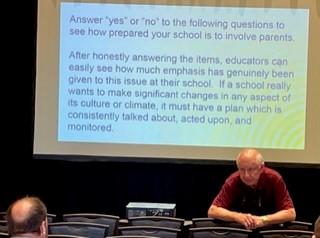Forming the Village: Ideas for Connecting with Caregivers to Reach Every Student
Prefer to listen? Check out the audio recording of this post instead.
They say it takes a village to raise a child, and as educators, you are a significant part of that village. But you aren’t the whole village.
When it comes to reaching every student in your school, you need help. This is why having good relationships with your students’ caregivers is so important.
This was the focus of Dave Shepard’s 2023 Making Schools Work Conference session “How to Improve the Quality and Quantity of Your Caregiver Involvement – 50 Simple Ideas.”
In the session, he started by asking us, “Are you serious? How fully do you understand the importance of parental involvement in your school plans?”
Student education is a shared responsibility between schools, educators, parents and the community. Parental involvement in a child’s education has a significant impact on their academic success and overall development. However, many schools often overlook the crucial role that parents play in their students’ educational journey.
Tip 1: Check the Data
How can schools tell that parental support is effective? It’s pretty easy: just look at the data.
At Dave’s school, the need for improved parental support was identified through comprehensive data analysis over a two or three-year period. Data analysis can reveal patterns and areas where parental involvement can make a significant difference in students’ academic performance and well-being.
Gathering this data can help you pinpoint places where caregiver support is lacking in your school, and it can help you determine where to focus your efforts. Gathering the data early can help better ensure both the quantity and quality of the caregiver support you receive.
Tip 2: Put Parental Involvement Directly in Your School Improvement Plans
One of the first things you can do to improve parental/caregiver involvement is to make sure this is a major focus for your whole school.
If your school or district has a detailed School Improvement Plan, it is essential to examine how parental involvement is addressed within it. Parental involvement should be a key priority in any school plan, as it greatly influences student outcomes and school success.
In his presentation, Dave Shepard pointed out that in his school’s plan, improved parental involvement is listed as one of the top three priorities. Recognizing the significance of parental engagement is the first step towards fostering a collaborative relationship between parents and the school community.
Tip 3: Allocate Specific Resources to Increasing Parental Involvement
Let’s be upfront about this: Like everything else in life, this is going to take a little bit of time and money. You need the resources to create a program that will encourage and empower parents to become active partners in their child’s education.
Allocating a specific budget for parental involvement initiatives is crucial. Providing financial support ensures that necessary resources are available to implement effective programs.
If you are really serious about getting this caregiver support, you need to make sure it is a part of your budget.
Tip 4: Communication Is Key
If you are trying to get parents more involved in the school, then you shouldn’t be keeping it a secret. At every stage of the process, you should be talking about the goal, the process, the progress, the setbacks and the successes.
You should be communicating with the parents all throughout the school year, but you also need to make sure you communicate with stakeholders too. Your school’s action plan should emphasize the importance of ongoing communication and regular reporting of parental involvement initiatives to all stakeholders.
Transparency in reporting builds trust and keeps parents, teachers and the community informed about progress and areas that may need further attention.
Tip 5: Encourage Meaningful Parent-Teacher Relationships
Building strong parent-teacher relationships is essential in promoting parental involvement.
There are many things you can do to help increase involvement.
Some ideas include the following:
- Regular open houses
- Family nights
- Community events
- Regular correspondence
Each of these offers opportunities for parents to meet teachers, understand school policies and collaborate on their child’s education.
Tip 6: Provide Resource Materials to Parents
Want an easy way to make sure more caregivers are involved? Give them the resources they need to get involved!
Equipping parents with helpful resources and guidance on various topics related to education, child development and academic support can empower parents to become more actively involved in their child’s learning journey.
Tip 7: Utilize Technology for Parental Engagement
Along with giving parents and guardians the information they need to be involved, it is important to create easy ways for parents to stay in the process. One such means to make involvement easier for parents is to utilize the right technology.
Employing modern technology, such as voicemail systems with parental options, can facilitate easy communication between teachers and parents. This enhances accessibility and streamlines the exchange of information.
Tip 8: Offer Incentives and Recognition for Positive Engagement
We can say that education is its own reward all day long, but at the end of the day, we all know that sometimes giving out candy, a free-homework pass or some other small incentive can keep students motivated.
The same can be said for parents, too!
Recognizing and rewarding parents for their active participation can motivate them to keep coming back. Positive reinforcement encourages more parents to engage actively in their child’s school life.
Let them see that you recognize the time they are putting into their child’s education and that you appreciate it, and they’ll keep doing it.
Tip 9: Foster Cultural Awareness and Inclusion
Just like you keep different cultures and needs in mind when dealing with your students, you should do the same when encouraging their parents to get more involved.
In diverse school communities, it is essential to embrace cultural differences and provide inclusive spaces for all parents.
Understanding and respecting cultural norms can enhance the effectiveness of parental involvement initiatives.
50 Ways to Get Parents More Involved
Along with some of these ideas, we went over 50 different ways to accomplish some of these goals. Here are a few examples:
- Arrange flexible hours for all conference days.
- Do a faculty bus tour around the school district so staff can see where students come from.
- Adopt a three-rings maximum policy for answering all calls in the school.
- Set up homework help stations in different neighborhoods so parents can show up away from the school building, where they may feel more comfortable.
- Get a copy of all required materials, such as textbooks, in the public library, where parents can check it out after school hours when a student forgets to bring it home.
To see all 50 tips, check out the session slides.
[File: 15897]
Final Thoughts
Parental involvement is not just a checkbox on a school improvement plan; it is a fundamental aspect of a successful education system. Engaging parents with their child’s education positively impacts student outcomes, school culture and overall community involvement.
By prioritizing parental support, schools can create a collaborative environment that nurtures students’ academic success and personal growth. Let us embrace parental involvement with enthusiasm and dedication, knowing that together, we can build a stronger foundation for our children’s future.
For more tips like these, make sure to subscribe to our Promising Practices Newsletter.





